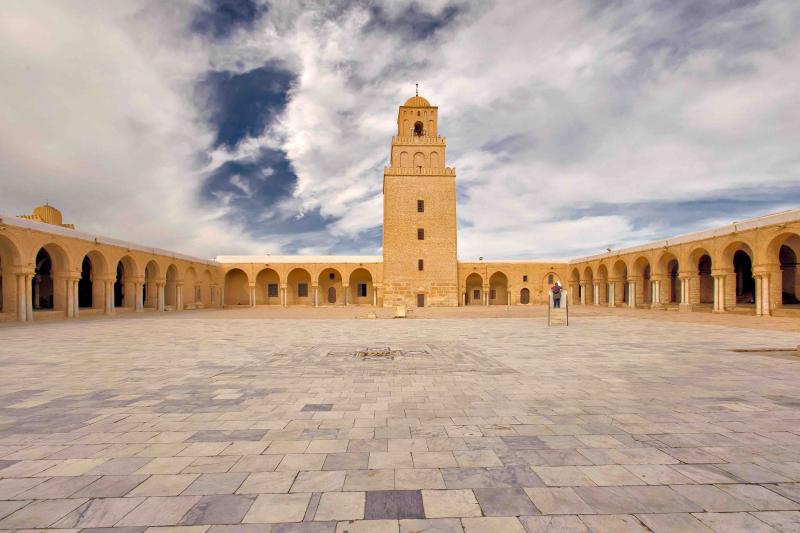KAIROUAN, Tunisia — Tunisians boast that Kairouan, a couple of hours south by car from Tunis, is Islam’s fourth holiest city, after Mecca, Medina and Jerusalem. Perhaps. Ethiopians say the same of Harar. Both Kairouan and Harar are UNESCO World Heritage Sites. Both know Islam from its very first century. However, fourth holiest or not, Kairouan wins over Harar in terms of age. It was founded nearly 340 years earlier.
More to the point, Kairouan takes its self-arrogated status of the fourth holiest city very seriously. A large public sculpture representing carpets from four points of the Muslim world welcomes visitors entering the city. Further along, there is a public monument composed of the Arabic calligraphic rendering of Allah.
Residents take enormous pride in the city’s Great Mosque, which goes by the name of Sidi Uqba. Named for Uqba ibn Nafi, the Arab commander who founded Kairouan in 672, the Great Mosque is the oldest Islamic building in North Africa and is simply vast — 135 metres long by 80 metres wide.
Sidi Uqba is in Kairouan’s walled city, where 15,000 people live and which still has 3.5km of the solid protection first erected around the medina in the seventh century. The original was destroyed — along with most of Kairouan — in 1057 but it was rebuilt some 600 years later. The dull mustard colour of the thin brick used for the wall has a name, Sahara. It is specific to Tunisia’s location on the edge of the world’s largest desert.
In Kairouan’s walled medina, there are multiple echoes of the link to early Islam and especially to Prophet Mohammad. The mosque of the three doors has the mausoleum of Abu Zamaa Al Balaoui, a friend of the Prophet, who arrived in Kairouan in 654 and died that year during a battle with Berbers. Legend has it that Al Balaoui carried with him three hairs from the Prophet’s beard and is buried with them. Tunisians call Al Balaoui, Sidi Sahbi.
Another link between Kairouan and early Muslim culture is found in the Achrafs neighbourhood of the medina. There stands the home of Al Aouani, a family that proudly counts a cousin of the Prophet as one of its ancestors.
The Aouanis have both religious and royal credibility — they established a madrassa, have a mausoleum and they hosted Habib Bourguiba, independent Tunisia’s first president, as well as Britain’s Queen Elizabeth II. However, you wouldn’t know the Aouanis’ glory days from their modest street door, set in a wall that meets the other side by way of a brick arch locally called “sabat.” It is a corruption of the French word for slipper.
The understated Aouanis could almost be said to represent the way Kairouan joins its past to the present. Proudly but sotto voce. Kairouan is not a city that’s loudly advertised by Tunisia as a destination for tourists from the Muslim world or beyond but it has much to offer to travellers with varied interests. La Kasbah, the city’s best hotel, is a beautiful and vast echoing space, built into the mediaeval wall. Kairouan city — both the medina and the modern part — is busy, with the business of life.
There is the formidable Grand Mosque, built within a half-century of the Prophet’s death and enshrining the age-old principle of wise recycling — mismatched Roman columns are reused in the inner courtyard.
Kairouan has carpets, for which it has been famous for 1,500 years. In the fifth century, Greek poets wrote about the rugs of Carthage and fealty was paid to the caliph of Baghdad partly in the form of Tunisian rugs. Even today, carpets are everywhere in Kairouan, woven by the women of the province into pile rugs (zerhiya) and short-nap. The latter fall into two categories — mergoum, with a diamond pattern worked into a neutral ground, and klim, with alternate strips of natural-coloured wools. Both are beautiful.
Then there is Bir Barrouta. The 17th-century well in the medina is supposed to have a miraculous holy link to the Zam Zam in Mecca. It is an interesting place to visit for the atmosphere alone. A camel powers the pulley system, urged on by a little man wearing green glasses and an air of undoubted authority. In Bir Barrouta, he is the sultan.
The bustling (and very clean) medina offers wondrous — and impractical — wares: Elaborately dressed bottles that should only be used to store rose water; different coloured rocks of incense; makroudh, Kairouan’s signature date pastries. On the Souk des Tapis (Market of Carpets), there are two interesting food options. A shop that specialises in brik, a Tunisian version of the Turkish borek, and Restaurant Barrouta, with its signature kafteji inside a pillowy round of bread. The Tunisian favourite is a mixture of tomatoes, peppers, eggs and often zucchini and potatoes, too.
Close to Kairouan and well worth a visit is the Museum of Islamic Art in Raqqada. It is housed in a building that once was Bourguiba’s house. He gifted it to the nation and the museum has since become a store of eclectic and fascinating treasures.
There is an eighth-century Quran written in Kairouan in the Hijazi script; a ninth-century sundial and surgical instruments; an astrolabe, the 12th-century equivalent of Google Maps.
There are pages from the famous ninth-century Blue Quran, one of the most exquisite early examples of the Holy Book, with its richly dyed parchment and bright ink. Pages from the Blue Quran are scattered in museums throughout the world. The head of the Raqqada Museum’s manuscripts department said each page is valued at more than $330,000.
Kairouan has magic and mystery and it’s on the map. Go.


